Back to "Cave Protection
Home"
INTRODUCTION
The underground environment is subject to many influences and things
that can have destructive effects. Many of these factors do not
relate to caving or cavers, and the cavers they can do little to solve
them. Some examples:
a) the destruction of the cave itself
- because of quarry activities (e.g. Grotte de Hotton)
- because of road or tunnelling works, ski-infrastructure etc.
(e.g. Grotte du Viaduc in Remouchamps).
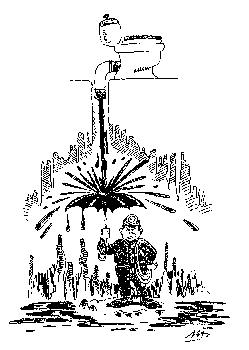 However,
and this is some kind of paradox, many a cave, that did not have a natural
entrance, has been discovered during such works! (E.g. Ste. Anne, Hotton,
Nys, Lucienne, Enfer-Fissures, Heinrichs, Puits-aux-Lampes, Ros? etc.)
However,
and this is some kind of paradox, many a cave, that did not have a natural
entrance, has been discovered during such works! (E.g. Ste. Anne, Hotton,
Nys, Lucienne, Enfer-Fissures, Heinrichs, Puits-aux-Lampes, Ros? etc.)
b) the pollution of the underground river
- commonly because of sewers and (domestic) waste water
- because of road drainage
- because of waste dumps in sinkholes (often making the cave
inaccessible as well, e.g. Trou des Photophores in Comblain)
- because of people dumping corpses of animals
In Belgium this is one of the main karst protection problems; for
many landowners and even city administrations, a sinkhole is the best
and cheapest way to get rid of sewer water. Hundreds of sinkholes in
Belgium are being misused for this, legally or illegally! Often the
entire cave has become inaccessible (Chantoir du Beau-Vallon), in most
other cases, visiting the cave is very unpleasant (e.g. Abime de la
Chawresse).
THE EFFECTS OF "CAVING"
O.K., so we cannot be held responsible for the problems mentioned
above. But what about us then?
First one must realize that practising speleology has always
a destructive effect on the cave. Without any doubt the best
protection for a cave is to close it forever, or even better, never
to discover it!
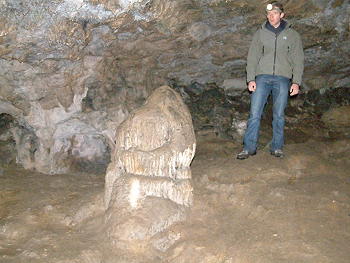 Most
cavers will stagger when hearing this, but most cavers have never had
the opportunity to see what a freshly discovered cave looks like. In
such a cave, everything sparkles and shines, the clay floor does not
show a footstep, the limestone rocks and walls are still clean . How
different will such a cave look after one year of visiting, how totally
unrecognizable after ten years!
Most
cavers will stagger when hearing this, but most cavers have never had
the opportunity to see what a freshly discovered cave looks like. In
such a cave, everything sparkles and shines, the clay floor does not
show a footstep, the limestone rocks and walls are still clean . How
different will such a cave look after one year of visiting, how totally
unrecognizable after ten years!
(Look at this picture: made in
Trou de la Louve (Nettinne): except one totally muddied and "abused"
stalagmite that was too big to carry, every other formation in this
room has been smashed and stolen. The calcite floor is only a muddy
and trampled shadow of what it once looked like.)
So it does not come as a surprise that the most passionate cave protectors
are mostly people that discover caves ... simply because "they know".
Often they are forced to close the cave (sometimes even permanently)
and apply access regulations, if they want to preserve the original
beauty of the cave.
Of course, permanently closing all caves, or stop searching and exploring
new caves, would also mean the end of caving as a sport and a science.
This would be a disaster as well, because in many domains (biological,
hydrological, geological, archeological etc..) it is very important
to keep on studying and exploring caves. And, but this is a philosophical
point of view, does beauty even exist if the human eye cannot see or
judge it?
So it is clear that we must find a way of caving that will have a
minimal impact on the cave itself, and if possible no impact at all.
Apart from all kinds of measures that we can take to protect a cave,
which are explained later in this article, the most important
factor is our own behaviour. I will try to sum up the
sorts of damage that we cause in caves and that are directly a result
of our own wrong habits.
1. DIRTYING FORMATIONS WITH MUD
The fossil levels of many caves are often nicely decorated with flowstone
formations. Unfortunately, just because of their fossil nature, the
floor of these galleries is often very muddy. Boots, oversuit
and hands or gloves of a caver will quickly get very muddy too, and
this is not really compatible with all the clean, delightful calcite
formations around.
Many a caver has the bad habit to touch or hold on to everything
in his surrounding, often because having a hold for a hand gives you
the idea of being more stable on your feet, especially in the slippery
cave environment. "Everything", means most of the time stalagmites,
and yes they offer perfect handholds. I would almost say that this behaviour
is almost fundamental. Every beginning caver will do it.
But sometimes they even do it deliberately, how often don?t we see
caving pictures where one of the models is touching a nice formation,
or worse, is standing on top of it?
Not only stalagmites, but also flowstone floors, curtains and "gours"
(pools) are being muddied and trampled. This is the beginning of a chain
reaction, because the next caver will reason "since that formation is
already dirty, I can touch it too".
Muddied formations will never get clean again. Cleaning
actions are often unsuccessful, because of the very porous nature of
calcite: it absorbs the mud.
(Picture: an extreme example of
wrong behaviour: a muddy caver climbing between flowstone curtains and
dirtying them forever.)
We can avoid muddying formations by following next 4 rules...
a) Don?t touch formations. Stay and admire them from a safe
distance, if possible. When near to concretions, move more slowly. This
should really become your second nature, a basic instinct!
b) When touching formations is inevitable, your hands, feet and
clothing must be clean. This means often: take off your boots, your
gloves, and sometimes even your oversuit. I know: it sounds easy but
in practice it is a big effort, especially in "full exploration fever"!
But realize that nobody has the right to dirty a formation just to
satisfy his own curiosity.
Some tips:
- If your socks aren?t clean (anymore) : go barefoot; or turn your
socks inside out.
- An empty plastic bag should be a standard piece of equipment in
a decorated cave: lay it on the floor and stand on it while taking of
your boots; this way you keep your socks clean. It can also serve to
carry your muddy boots in, across the decorated area.
- a small headlight (Petzl Tikka or so) is needed when your hard-hat
or battery is dirty too.
- when visiting a decorated cave, always wear gloves. This way your
hands remain clean. If you don?t like to cave with gloves: take a set
of clean gloves with you that you can wear in the decorated areas.
c) Everyone in the party must follow the same track: this
way the pollution is limited to this one track and its immediate surroundings.
d) Watch each other and warn each other! Not everybody is
an expert in avoiding formations, and again: holding on to formation
is a basic instinct of many cavers. The simple fact that the first guy
in the party says something like "take care, here is a nice formation
at your left" can avoid much damage.
These 4 simple rules are nothing shocking or new: in fact we all
know them and apply them... at home. Nobody would even think about stepping
into his nice, clean car while still carrying his muddy oversuit. Nobody
would even dare to enter mothers? kitchen while wearing muddy boots.
So, why is it that most of us just forget these habits as soon as we
step into a cave?
Luckily, we can make the caver?s task a bit easier, by taping
off formations to materialize a "route" where the caver can
go without damaging the cave. "Taping off" is best done with very thin,
coloured rope or, but this is not very aesthetical, with red/white plastic
tape. It should be done as soon as possible after the discovery. Obviously,
we cavers may never cross these tapes or remove them, not even
to take a picture! You can read a lot more
about these protection techniques here.
2. BREAKING FORMATIONS
 Entire
caves have been smashed to pieces, because of plain ignorance and stupidity,
and sometimes even deliberately, out jealousy or just greed. Most often
by "daytrippers", mineral collectors, adventure seekers... i.o.w. the
non-caving community...knowing little about a cave?s vulnerability.
Entire
caves have been smashed to pieces, because of plain ignorance and stupidity,
and sometimes even deliberately, out jealousy or just greed. Most often
by "daytrippers", mineral collectors, adventure seekers... i.o.w. the
non-caving community...knowing little about a cave?s vulnerability.
"Real" cavers also break formations, but most of the time accidentally.
Formations are very fragile, often they are very long but quite thin
as well. Calcite is not very strong and a little push is already sufficient
to break a stalagmite. Stepping onto the thin border of a "gour" pool
is also the best way to step right through it!
How do we avoid this? Again by applying the rule "Don?t touch formations.
Stay and admire them from a safe distance, if possible"!
(Picture: deliberately broken formations
in Trou de l'Eglise (Mont-sur-Meuse). Also mind the black soot deposit
onto the formations, because of the excessive use of carbide lighting
in this cave! More on this later in this article.)
3. WALKING ON SEDIMENTS
The cave floor, especially if it is a mud floor, is very easily destroyed.
Frequent walking on the mud or clay floors will soon wear them out,
which results in some caves in knee-deep "ski-tracks". However, virgin
mud floors are very beautiful. So we must try to limit the damage to
a route as narrow as possible. So don?t zigzag through the gallery,
but follow a narrow track.
Cave floors can often reveal valuable information about the cave?s
origin and geneses, and sometimes even be of archeological value (footprints,
bones, fireplaces or other material).
Taping off the route should be considered. Plastic foil, rolled out
and forming a track, can also be a good means to protect the floor.
However, the plastic should be heavy enough, otherwise it will stick
to your (generally muddy) boots: empty garbage bags will not
do!
4. DIRTYING WALLS WITH MUD, PAINT, INSCRIPTIONS
It goes without saying (but I will anyway) that making inscriptions
or graffiti on cave walls, is out of the question. 20.000 years ago
cavemen painted on the cave walls... nowadays this is considered as
an act of vandalism.
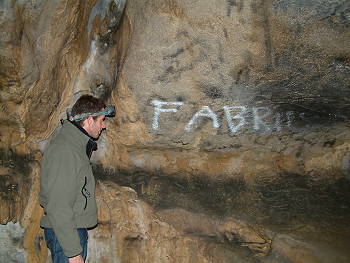 (Nevertheless,...
it still happens: picture taken in Trou de la Louve, Nettinne...)
(Nevertheless,...
it still happens: picture taken in Trou de la Louve, Nettinne...)
Also absolutely forbidden is making arrows or other
marks (with the carbide flame, paint or mud) in order to find your way.
If you are unsure of the way in the cave, then mark your way by making
a small pile of rocks (called a "cairn"). At the way back, remove them
again, please.
When visiting complex or labyrinth caves, take red/white tape or
even better Scotchlite markers with you. Yet again: remove them afterwards.
Not everyone likes it when walking through a cave that has been "over-marked".
Please allow other cavers their "exploration of the unknown". In some
caves (e.g. Dent de Crolles) there are so many marks that it isn?t funny
anymore.
Finally, in some caves the walls consist of really clean, bright
rock: don?t lean against it with your muddy hands or oversuit.
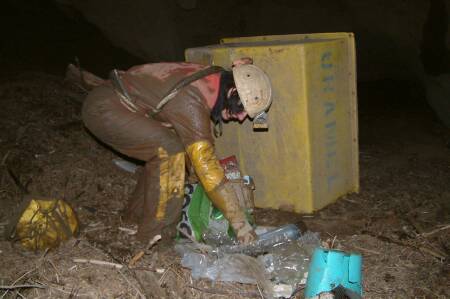 5.
LEAVING GARBAGE
5.
LEAVING GARBAGE
Most people will agree that it is very disturbing to find empty cans,
bottles, used batteries and other litter in a cave. If you are big/strong
enough to carry all that stuff into a cave, then taking it out again
shouldn?t be much of a problem, one would think. Apparently not!
Fortunately, this kind of pollution is most of the time only visually
offensive, and not really very offensive for the cave environment, and
can be removed quite easily as well. As a caver, we should never be
too proud to take out other people?s garbage!
(Picture: cleaning up litter in
a cave. Even the giant yellow container is garbage, washed in by the
floods!)
A special kind of pollution, and this time really difficult to remove,
is the waste from carbide generators. More on this later in this article.
6. URINE & FAECES
It is quite normal that on a long caving trip one has the need to
"go to the toilet". But in caves, there are no toilets. So, we need
common sense and discipline. I guess many cavers have had the unpleasant
experience to enter a cave passage in which some irresponsible caver
had urinated (or worse...). On a couple of occasions, the unbearable
odour in a small cave room has forced me to abandon a survey trip once!
At home, we don?t urinate right there where we happen to be standing.
We are humans, not cows! So, for God?s sake, in a cave we don?t do this
either. Your urine can smell for weeks in a cave. The best attitude
is to take an empty plastic bottle with you. Women will
be grateful if it has a wide opening. I have visited caves where the
guide had an empty 5 litre Curver container with him... by the end of
the day, it was nearly full!
Second best is to find yourself a "strategic" place, away from the
normal cave passage, and with running water. An underground
river is perfect, but even a small trickle of water can wash away your
urine in a few hours. But you must be certain that they are not
capturing the water to provide drinking water to locals (though
urine is sterile).
Of course in a dry cave, this is not possible and then I suggest
you dig a small hole into the mud floor that you cover
up again afterwards (that's how my cat does it!).
As for human excrements: we should really avoid this. In case of
long underground
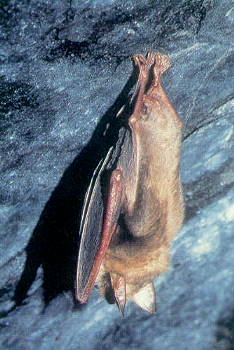 stays,
plastic zip lock bags are recommended to take everything
out. If you don?t have them; the "dig-a-hole" technique is a good alternative,
and please always cover it with sand again. In any case: never ever
defecate into water, running or not. Faeces are full of bacteria! I
have had the unpleasant experience once in an underground camp at -500m:
we had made a cup of tea with water from a crystal clear pool nearby.
After having drunk our tea, somebody suddenly noticed the presence of
a pile of human shit, at the bottom of the pool. I can assure you that
this was very unpleasant.
stays,
plastic zip lock bags are recommended to take everything
out. If you don?t have them; the "dig-a-hole" technique is a good alternative,
and please always cover it with sand again. In any case: never ever
defecate into water, running or not. Faeces are full of bacteria! I
have had the unpleasant experience once in an underground camp at -500m:
we had made a cup of tea with water from a crystal clear pool nearby.
After having drunk our tea, somebody suddenly noticed the presence of
a pile of human shit, at the bottom of the pool. I can assure you that
this was very unpleasant.
7. DISTURBING ANIMALS
We don?t see many animals in a cave, most of them are not big and are
well hidden. If we see any, then chances are quite high that it are
bats. Never disturb them. Don?t touch them, stay at a safe distance,
don?t shine direct light on them. Some species are even disturbed by
your body heat alone. All bats are particularly vulnerable during the
winter. Waking them out of their sleep might result in the animal dying.
8. CARBIDE LIGHT
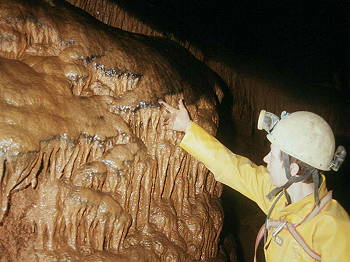 Carbide
light has several bad consequences. For me the most important one is
the emission of very fine carbon particles by the burning
flame, just like a burning candle does. They are being transported through
the air, because in most caves there is a noticeable draught, and deposited
on all non-vertical surfaces in the cave. In some Belgian caves that
cavers with carbide light frequently visit (e.g. Nr. Two in Trou Bernard,
Réseau Noir in Trou Weron), this effect has blackened every square centimetre.
Carbide
light has several bad consequences. For me the most important one is
the emission of very fine carbon particles by the burning
flame, just like a burning candle does. They are being transported through
the air, because in most caves there is a noticeable draught, and deposited
on all non-vertical surfaces in the cave. In some Belgian caves that
cavers with carbide light frequently visit (e.g. Nr. Two in Trou Bernard,
Réseau Noir in Trou Weron), this effect has blackened every square centimetre.
Picture: black carbon slurry dripping
off a big flowstone formation. This cave (Aven des P?res, Gard, France.)
is being used frequently for "safaris" organized by nearby outdoor centres.
They use carbide lighting... Despite the giant dimensions of the cave
(gallery sections minimum 10x15 metres), the black carbon has been deposited
up to 10 metres high and all formations are visibly black. This process
took place in hardly 15 years, the cave was discovered in the ?80s,
and at that time the flowstone formations were sparkling and clean.
Conclusion: in decorated caves, the use of carbide light is
a catastrophe and is should be avoided at all cost, or even better,
be forbidden.
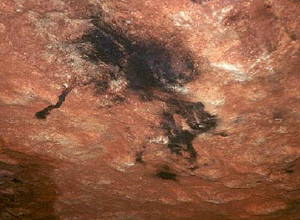 Another
problem is the fact that when one approaches the cave ceiling too close,
the flame will leave a black spot, which is again carbon
(see picture at the left). This terribly unaesthetic plague
has marked practically every Belgian cave. We can ask ourselves: how
would the caving community react if somebody would take a can of red
or green paint and start painting coloured dots at the ceiling of every
gallery in all of our caves. The reaction is easy to predict: one would
not accept this, they would probably lynch the guy who did it!
Another
problem is the fact that when one approaches the cave ceiling too close,
the flame will leave a black spot, which is again carbon
(see picture at the left). This terribly unaesthetic plague
has marked practically every Belgian cave. We can ask ourselves: how
would the caving community react if somebody would take a can of red
or green paint and start painting coloured dots at the ceiling of every
gallery in all of our caves. The reaction is easy to predict: one would
not accept this, they would probably lynch the guy who did it!
So here we see the hypocrisy of the carbide light cavers (also known
as "the ceiling burners"): putting black spots everywhere in
a cave is OK, other colours are not!
Yet another problem are the very smelly gasses produced by
the carbide flame. A cave that has been visited by carbide light cavers,
smells for hours. This is certainly not very healthy for cave fauna,
nor for other cavers.
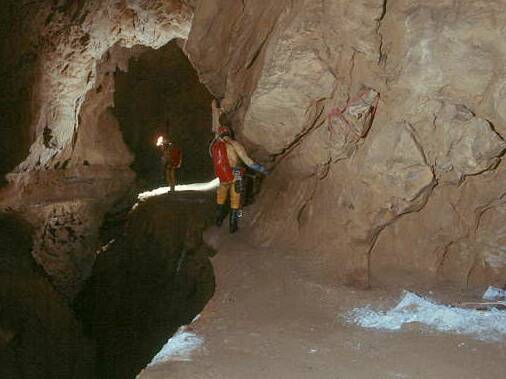 Finally
there is the pollution caused by carbide waste that many
irresponsible cavers leave in a cave. For most cavers, when you say
that carbide is bad for a cave, this is the only thing they think of...
Wrong! Compare it with a car. If I tell you that a car is bad for the
environment, then you will in the first place think about their exhaust
gases, the noise they make and so on. You will probably not say that
cars are only bad because some people dump their used car in nature
because a) we can avoid the dumping and b) even if we don?t dump used
cars, they still remain polluting.
Finally
there is the pollution caused by carbide waste that many
irresponsible cavers leave in a cave. For most cavers, when you say
that carbide is bad for a cave, this is the only thing they think of...
Wrong! Compare it with a car. If I tell you that a car is bad for the
environment, then you will in the first place think about their exhaust
gases, the noise they make and so on. You will probably not say that
cars are only bad because some people dump their used car in nature
because a) we can avoid the dumping and b) even if we don?t dump used
cars, they still remain polluting.
(Picture: piles of white carbid
waste disfiguring a cave)
The same goes for carbide. Carbide is bad, in the first place because
the gases pollute the cave; not because people dump carbide waste. We
can avoid dumping the waste... but we cannot avoid the pollution caused
by the carbon particles in the gas.
Don?t get me wrong: I am not saying that carbide waste is good. The
white piles of carbide waste are aesthetically very disturbing, and
cleaning the mess up once the carbide waste has dried out is very difficult
or hardened.
Every caver that is using carbide should always take a piece of plastic
with him, 40 by 40 cm will do. It can be used to lay on the floor when
cleaning the carbide generator, without spilling the waste onto the
floor. Some carbide generators (Petzl Ariane) open in the middle of
the filling, and cannot be emptied without spilling carbide waste.
Of course, the carbide waste should be taken out of the cave.
A plastic bag or even better an inner tube of a car tyre must be standard
equipment!
But, it goes without saying that the only good way to avoid
all the problems listed above, is to use only electric light.
Not only will we stop polluting, but we will also have less light troubles
in muddy, wet or narrow caves (typical Belgian caves, in other words).
There are many very good and solid lighting systems around. The past
couple of years we are witnessing the increasing popularity of "White
Led" systems that are not only very solid, but offer a long autonomy
and a soft, well spread light that can be compared with carbide light.
Strangely enough, criticizing carbide light remains a real "taboo"
in some countries (France, to mention one!). But in many countries (such
as the U.K.) using electric light in a cave is normal, and English cavers
are certainly enjoying their caving sport as much as any other caver.
FREE ACCESS TO CAVES: THE INFLUENCE OF CAVERS
Our own behaviour is very determining to keep a free access to many
caves!
Imagine this:
One sunday morning, very early - you are still in bed - , a couple
of cars arrive and park right before your door. A bunch of cavers gets
out, talking and laughing aloud and waking you up. Some strange ritual
starts outside: first one by one they start peeing against your fence.
Then they undress themselves, without being embarrassed at all they
strip totally naked. Then they get into their caving clothes and put
on their caving gear with a lot of noise. Finally they head of to the
cave, taking a shortcut through your garden. Six hours later they are
back... the same ritual commences but this time in the opposite sequence...
After they are gone, some empty cans and a pile of carbide waste remain
in your garden.
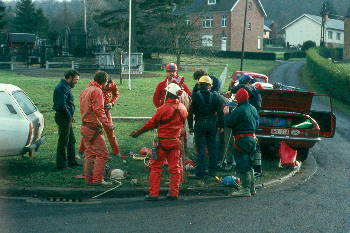 Just
imagine this happening, in your street, before your
door. Unless you are a very tolerant person, you will not let
this happen very often.
Just
imagine this happening, in your street, before your
door. Unless you are a very tolerant person, you will not let
this happen very often.
Unfortunately, this situation is happening every weekend
somewhere near a Belgian cave! So, it is not surprising that many a
landowner has simply closed off his cave or will not allow cavers to
start digging for new caves on his land.
(Picture: in the Belgian caving
regions, cavers are sometimes part of the scenery... but often not very
welcome anymore!)
Of course, we can so easily avoid all this; again it is just a matter
of common sense and a bit of discipline:
Belgium is a country with few big caves (a few dozens!), to be shared
between a lot of cavers (a few thousands). It is also a country with
a very dense habitation, and often caves are very near to houses or
villages. And it is also a country where cavers are not particularly
aware of cave protection, because historically this was not
considered as important, in many caving clubs or during caver training.
An unfortunately it most caver trainings, in Belgium or even France,
still focus on the technical aspects of caving!
Because of all these factors, caves are under a lot of pressure and
caving has become more and more difficult. It is extremely important
that all cavers start caring about our caves, their environment
and the local population, and start applying "good caving manners" as
described in this article.
This is the only way to a) keep our caves from further degradation
and b) prevent more caves from being closed forever by their landowners.
Finally: all problems that I have mentioned in this article, are
in close relation to the number of cavers. The more people, the more
problems. So please keep caving parties small.
